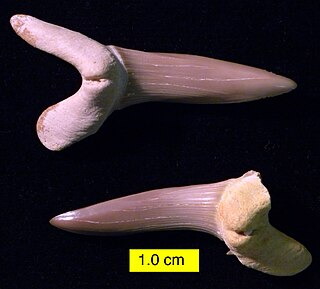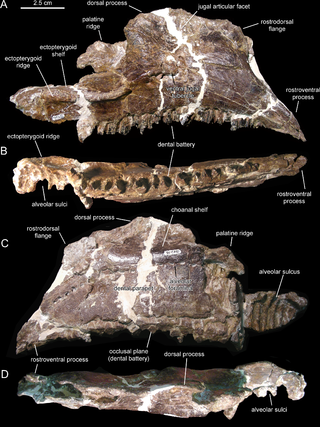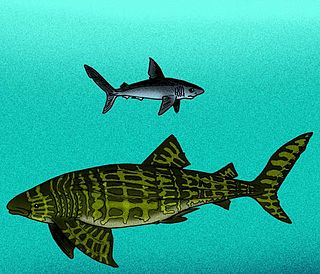
Ampelosaurus is a titanosaurian sauropod dinosaur from the Late Cretaceous Period of what is now France. Its type species is A. atacis, named by Le Loeuff in 1995. Its remains were found in a level dating from 71.5 million years ago representing the early Maastrichtian.

Sclerorhynchus is an extinct genus of ganopristid sclerorhynchoid that lived during the Late Cretaceous. The genus Ganopristis is considered a junior synonym of Sclerorhynchus. It was a widespread genus, with fossils found in the Middle East, North Africa, Europe, and North America. While it had a long rostrum with large denticles similar to sawfishes and sawsharks, its closest living relatives are actually skates. Complete specimens of S. atavus show that its fin arrangement was similar to skates, with the pectoral and pelvic fins touching, both dorsal fins located behind the pelvic fins, and a reduced caudal fin.

Scapanorhynchus is an extinct genus of shark that lived from the early Cretaceous until possibly the Miocene if S. subulatus is a mitsukurinid and not a sand shark. Their extreme similarities to the living goblin shark, Mitsukurina owstoni, lead some experts to consider reclassifying it as Scapanorhynchus owstoni. However, most shark specialists regard the goblin shark to be distinct enough from its prehistoric relatives to merit placement in its own genus.

Ptychodus is a genus of extinct durophagous (shell-crushing) sharks from the Late Cretaceous. Fossils of Ptychodus teeth are found in many Late Cretaceous marine sediments worldwide. Numerous species have been described. The youngest remains date to around 85 million years ago. A large number of remains have been found in the former Western Interior Seaway. A 2016 publication found that Ptychodus are likely true sharks belonging to Selachimorpha, rather than hybodonts or batoids as previously thought. Their life history coincides with the typical life of many other large sharks: they lived relatively long lives and were slow growing and produced large offspring and small litters.

Bananogmius is an extinct genus of ray-finned fish that lived in what is today Kansas during the Late Cretaceous. It lived in the Western Interior Seaway, which split North America in two during the Late Cretaceous. Some species like B. evolutus later reclassified as Pentanogmius.
The Marnes d’Auzas Formation is a geological Formation in southwestern France whose strata date back to the Late Maastrichtian. It is about 100 metres thick and consists primarily of marls with some interbeds of sandstones. It corresponds to sediments whose depositional environment evolved from the paralic domain at the base of the formation, towards a more continental domain in its upper part. The Marnes d’Auzas Formation was deposited in the west coast of the former Ibero-Armorican Island, which included much of France and Spain.

Anacoracidae is a family of extinct mackerel sharks that lived during the Cretaceous. It includes four valid genera: Nanocorax, Ptychocorax, Scindocorax, and Squalicorax. Two previously-included genera, Galeocorax and Pseudocorax, were reassigned to the family Pseudocoracidae.

Cretalamna is a genus of extinct otodontid shark that lived from the latest Early Cretaceous to Eocene epoch. It is considered by many to be the ancestor of the largest sharks to have ever lived, such as Otodus angustidens, Otodus chubutensis, and Otodus megalodon.

Canardia is an extinct genus of lambeosaurine dinosaur known from the Late Cretaceous Marnes d'Auzas Formation of Haute-Garonne department, in Occitanie region, southwestern France. The type species Canardia garonnensis was first described and named by Albert Prieto-Márquez, Fabio M. Dalla Vecchia, Rodrigo Gaete and Àngel Galobart in 2013. It is only known from juvenile specimens. The name of the genus comes from “canard”, the French word for “duck”, an allusion to the fact that this animal belongs to the hadrosaurids which are also known as duck-billed dinosaurs. The specific epithet garonnensis refers to the Haute-Garonne department where this dinosaur has been found. Although universally recognized as a lambeosaurine, its precise position within them is debated. Some authors consider it as a close relative of the genus Aralosaurus from Central Asia with which it would form the tribe Aralosaurini, while others include it in a more derived clade, the Arenysaurini in which all lambeosaurines from Europe and North Africa are placed. Canardia was one of the last non-avian dinosaurs and lived between 67,5 and 66 my on the former Ibero-Armorican Island, which included much of France and Spain.

Pseudocorax is an extinct genus of mackerel sharks that lived during the Late Cretaceous. It contains six valid species that have been found in Europe, the Middle East, North Africa, and North America. It was formerly assigned to the family Anacoracidae, but is now placed in its own family Pseudocoracidae along with Galeocorax. The former species "P." australis and "P." primulus have been reidentified as species of Echinorhinus and Squalicorax, respectively.

Sclerorhynchoidei is an extinct suborder of rajiform rays that had long rostra with large denticles similar to sawfishes and sawsharks. This feature was convergently evolved and their closest living relatives are actually skates. While they are often called "sawfishes", sawskates is a more accurate common name for sclerorhynchoids. The suborder contains five named families: Ganopristidae, Ischyrhizidae, Onchopristidae, Ptychotrygonidae, and Schizorhizidae. Several genera are not currently placed in any of these families. Sclerorhynchoids first appeared in the Barremian and went extinct during the Cretaceous–Paleogene extinction event, with former Paleocene occurrences being misidentifications or reworked specimens.

Eorhincodon is an invalid genus of requiem shark from the Late Eocene of Xinjiang, China, originally described as a whale shark. It is currently considered a junior synonym of Rhizoprionodon. The genus was originally erected by Li (1997) to include the species Eorhincodon tianshanensis, but Nessov (1999) used the preoccupied genus in a different paleontological context to include an unrelated species, E. casei, from Late Cretaceous Russian marine strata. A new genus, Pseudomegachasma, was erected in 2015 for E. casei to be transferred into.

Paraisurus is an extinct genus of mackerel sharks that lived during the Cretaceous. It contains four valid species, which have been found in Europe, Asia, North America, and Australia. A fifth species, P. amudarjensis, is now considered a synonym of P. compressus. While this genus is mostly known from isolated teeth, an associated dentition of P. compressus was found in the Weno Formation of Texas. It went extinct around the Albian-Cenomanian boundary, as a supposed Coniacian occurrence of "P. sp." is likely a misidentified pseudoscapanorhynchid.

Pseudoscapanorhynchidae is a family of extinct mackerel sharks that lived during the Cretaceous and potentially the Paleogene. It currently includes Cretodus, Eoptolamna, Leptostyrax, Protolamna, Pseudoscapanorhynchus, and possibly Lilamna.

Pentanogmius is an extinct genus of sail-finned ray-finned fish that lived during the Late Cretaceous in what is now Europe and the United States. Five species are currently recognized, 2 from Cenomanian to Turonian Europe and 3 better known species from Coniacian to Campanian North America. The American species inhabited large areas of the Western Interior Seaway, with fossil finds indicating a range from Texas and Alabama in the south to Manitoba, Canada, in the north.
Galeocorax is an extinct genus of mackerel sharks that lived during the Late Cretaceous. It contains a single valid species, G. jaekeli, that has been found in Europe and North America.
Nanocorax is an extinct genus of mackerel sharks that lived during the Late Cretaceous. It contains two valid species, N. crassus and N. microserratodon. It has been found in North America, Europe, North Africa, and the Middle East.
Truyolsodontos is an extinct genus of mackerel sharks that lived during the Late Cretaceous. It contains two valid species, T. estauni and T. magnus. It has been found in Spain, France, Ireland, and possibly Lithuania.
Pseudoscapanorhynchus is an extinct genus of mackerel sharks that lived during the Cretaceous. It contains one valid species, P. compressidens. It has been found in Europe, Asia, and North America.













